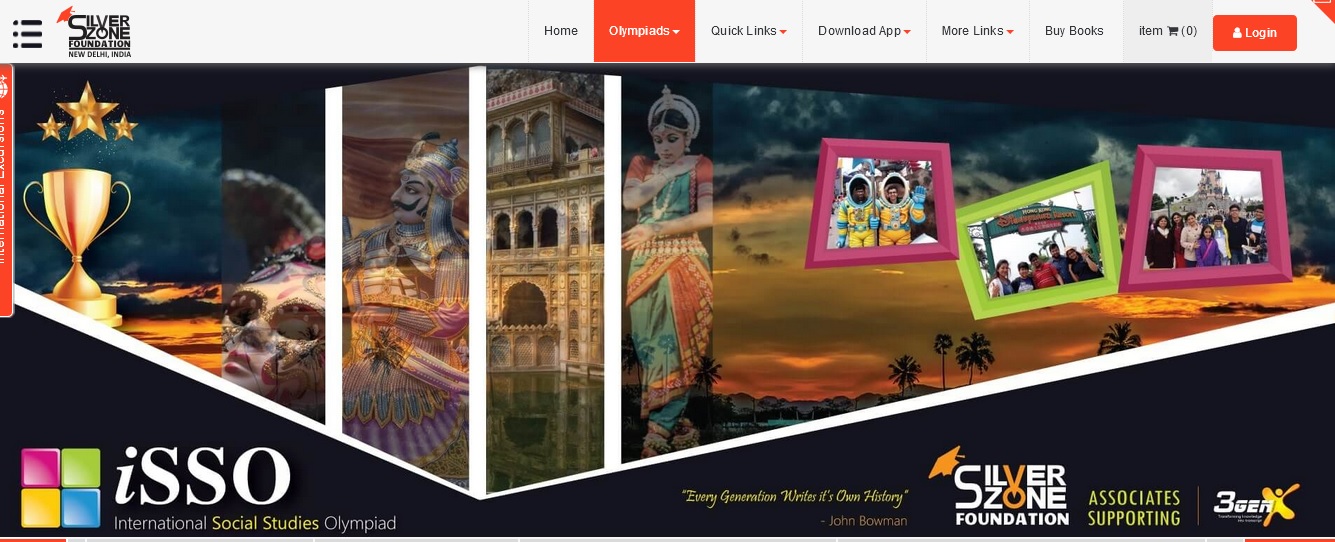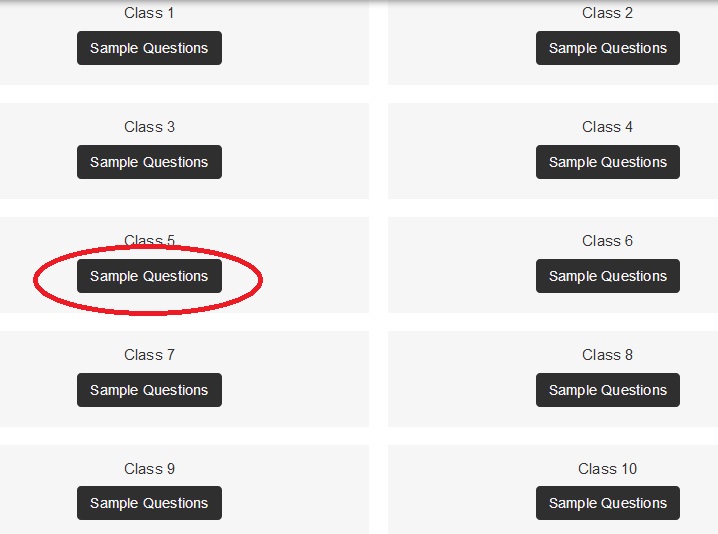SilverZone iSSO International Social Studies Olympiad 2018 Sample Question Paper
Name of the Organisation : SilverZone/ Silver Zone
Name of the Exam : International Social Studies Olympiad 2018
Document Type : Sample Question Papers
Category : Class I – X
Year : 2018
Website : https://www.silverzone.org/SubjectInfo/isso
SilverZone iSSO Sample Question Papers
The International Social Studies Olympiad, a test of competence and proficiency in History, Geography and Civics is held annually at the National and International levels based on syllabus prescribed by CBSE/ICSE and the State Boards.
Related / Similar Question Paper :
Silver Zone iSSO Olympiad Question Paper
Silver Zone iSSO Olympiad Question Paper 2017
The detailed Syllabus and Sample Test Paper are provided in this website, click the above links to download the Syllabus and Sample Test Paper class wise.

Instructions
** The Actual Question Paper Contains 50 Questions.
** The Duration of the Test Paper is 60 Minutes.
Download Question Paper :
Class 1 :
https://www.pdfquestion.in/uploads/pdf2019/33346-1isso.pdf
Class 2 :
https://www.pdfquestion.in/uploads/pdf2019/33346-2isso.pdf
Class 3 :
https://www.pdfquestion.in/uploads/pdf2019/33346-3isso.pdf
Class 4 :
https://www.pdfquestion.in/uploads/pdf2019/33346-4isso.pdf
Class 5 :
https://www.pdfquestion.in/uploads/pdf2019/33346-5isso.pdf
Class 6 :
https://www.pdfquestion.in/uploads/pdf2019/33346-6isso.pdf
Class 7 :
https://www.pdfquestion.in/uploads/pdf2019/33346-7isso.pdf
Class 8 :
https://www.pdfquestion.in/uploads/pdf2019/33346-8isso.pdf
Class 9 :
https://www.pdfquestion.in/uploads/pdf2019/33346-9isso.pdf
Class 10 :
https://www.pdfquestion.in/uploads/pdf2019/33346-10isso.pdf
iSSO Sample Questions

Class VI
1. Who among the following organized ‘Untouchable’s Conference’ in 1918?
(A) Mahatma Gandhi
(B) Dr.B. R. Ambedkar
(C) Jawaharlal Nehru
(D) B.G. Tilak
(E) None of these
2. Which of the following is an archeological source of Gupta Age?
(A) Araku Valley
(B) Prayag Prashasti
(C) Bhimbhetka
(D) Ajanta cave
(E) None of these
3. The mountain range that separates Asia from Europe is
(A) The Urals
(B) The Pamir
(C) The Andes
(D) The Himalayas
(E) None of these
4. ‘The girls are burden on their parents’ is an example of:
(A) Retarded thinking
(B) Progressive thinking
(C) Common thinking
(D) Stereotype thinking
(E) None of these
5. In India, which of the following cities was the dirtiest in 1994?
(A) Surat
(B) Patna
(C) Meerut
(D) Banaras
(E) None of these
6. Sangam literature belongs to:
(A) Jains
(B) Buddhists
(C) Kerala
(D) Tamils
(E) None of these
7. The lowermost limit of ice on the mountain top is called
(A) Snowline
(B) Icecap
(C) Glacier
(D) Iceberg
(E) None of these
8. The highest level of the three-tier Panchayat system in India is known as:
(A) Gram Panchayat
(B) Municipal Corporation
(C) Zila Parishad
(D) Nyaya Panchayat
(E) None of these
9. What is Jadeite?
(A) A type of metal
(B) A kind of stone
(C) An archeological site
(D) Name of a plant
(E) None of these
10. How was the irrigation done in Harappan cities?
(A) Watering of plants was done from specially build well.
(B) Water was directly supplied to the field from river when the plants were growing.
(C) Water was stored and supplied to fields when the plants were growing.
(D) All of these
(E) None of these
11. The earth rotates from________.
(A) East to West
(B) West to East
(C) East to South
(D) West to North
(E) None of these
12. Which local body of the city decides the day of the weekly market?
(A) Local police
(B) Municipal Corporation
(C) Residents of the locality
(D) Traders association
(E) None of these
13. India shares its land boundaries with:
(A) Six countries
(B) Five countries
(C) Seven countries
(D) Eight countries
(E) None of these
14. How many days the Constitutional Assembly took to complete the draft of the Constitution of India?
(A) 2 years, 10 months and 9 days
(B) 11 years, 2 months and 7 days
(C) 11years, 7 months and 2 days
(D) 2 years, 11 months and 17 days
(E) None of these
15. The map that shows the distributions of industries is a:
(A) Thematic map
(B) Physical map
(C) Political map
(D) All of these
(E) None of these
Class VII
1. In which of the following years the Supreme Court of India asked all the state governments to implement mid-day meal scheme in their schools?
(A) 2005
(B) 2002
(C) 2004
(D) 2001
(E) None of these
2. Who among the following revolted against Aurangzeb?
(A) Prince Akbar
(B) Prince Khurram
(C) Prince Salim
(D) Prince Babar
(E) None of these
3. Bengal tigers are found in:
(A) Mountains
(B) Plateau region
(C) Delta region
(D) Great plains
(E) None of these
4. Which of the following has been the people’s movement for democracy in recent past?
(A) Rose Revolution
(B) Bulldozer Revolution
(C) Tulip Revolution
(D) All of these
(E) None of these
5. Who first brought the teachings of the holy Quran to India?
(A) Sufi saints
(B) Mongols
(C) Migrants and merchants
(D) Shia Muslims
(E) None of these
6. Which of the following plants store water in their leaves?
(A) Bromeliads
(B) Rafflesia
(C) Banana
(D) Banyan
(E) None of these
7. The Sahara desert is also known as :
(A) Al-Azizia
(B) Al-Zazira
(C) Al-Khela
(D) All of these
(E) None of these
8. Delhi first became the capital of a kingdom under:
(A) Ghiyasuddin Balban
(B) Tomara Rajputs
(C) Qutbuddin Aybak
(D) Prithviraj Chauhan
(E) None of these
9. Each state in India is divided into different areas for the purpose of election. These areas are known as:
(A) Blocks
(B) Constituencies
(C) Assembles
(D) All of these
(E) None of these
10. Which of the following is a structure or pattern of rural settlements?
(A) Linear
(B) Scattered
(C) Compact
(D) All of these
(E) None of these
Class VIII
1. Birsa was born in a family of:
(A) Santhals
(B) Mundas
(C) Oraons
(D) Bhils
(E) None of these
2. In which of the following years the government amended the Child Labour Prevention Act, banning children under 14 years of age from working as domestic servants or as workers in dhabas, restaurants, tea shops etc?
(A) October 2006
(B) June-July 2001
(C) March 2003
(D) December 2005
(E) None of these
3. Which of the following is an example of agrobased industry?
(A) Cotton textile
(B) Petroleum
(C) Information technology
(D) Railway coaches
(E) None of these
4. A field left uncultivated for a while so that the soil recovers fertility is called:
(A) Fellow
(B) Follow
(C) Fallow
(D) Fillow
(E) None of these
5. Which of the following the government of India has to emphasise to ensure that every worker gets fair wages?
(A) Making of proper law.
(B) Regular inspection of work sites.
(C) Stringent punishment for violating the law.
(D) Both (B) and (C)
(E) None of these
6. Who issued a ‘farman’ granting the East India Company the right to trade duty free ?
(A) Murshid Quli Khan
(B) Aurangzeb
(C) Bahadur Shah Zafar
(D) Alivardi Khan
(E) None of these
7. Which of the following is true?
(A) India has a single judicial system for the entire country.
(B) The High Court of a State in India does not have any appellate jurisdiction.
(C) Police can keep a person in custody as long as they wish.
(D) The Supreme Court of India acts as the guardian of our fundamental rights.
(E) None of these
8. The uneven distribution of population in different parts of the world is mainly due to:
(A) Rugged topography
(B) Varied characteristics of land
(C) Vulnerability to water sources
(D) Varied characteristics of climate
(E) Both (B) and (D)
9. Victoria Terminus, the famous railway station in Mumbai, was built in:
(A) Gothic style
(B) Corinthian style
(C) Classical Greeko-Roman style
(D) Dorian style
(E) None of these
10. Tipu Sultan was killed in:
(A) The Third Battle of Panipat
(B) The Third Battle of Mysore
(C) The Battle of Seringapatam
(D) The Battle of Buxar
(E) None of these
Class IX
1. Which of the following supports the argument of the regional variations in the climatic condition of India?
(A) Northern plains are more fertile than Deccan plateau.
(B) Mawsynram registers the highest rainfall in India.
(C) On a winter night temperature at Drass in Jammu and Kashmir may touch as low as (–) 40°C, whereas on same night the temperature in Tiruvananthapuram may be 24°C.
(D) Rivers of South India are mostly rain-fed whereas the rivers of North are fed by the glaciers.
(E) None of these
2. Which of the following was an infamous concentration camp of the Nazis during World War II?
(A) Versailles
(B) Berlin bunker
(C) Reichstag
(D) Auschwitz
(E) None of these
3. Sarva Shiksha Abhiyan aims to promote education between which of the following age group of children?
(A) 6-15
(B) 5-10
(C) 6-14
(D) 5-14
(E) None of these
4. Jowar and Bajra grows during:
(A) Winter season
(B) Summer season
(C) Rainy season
(D) Throughout the year
(E) None of these
5. 23rd February 1917 was called the International Women’s Day for which of the following reasons?
(A) Russian women attacked the royal palace.
(B) Russian women started a new party.
(C) In many factories in Russia women led the strike against the government.
(D) Russian women got the right to vote.
(E) None of these
6. Who was Michelle Bachelet?
(A) The General of the Chilean Air Force who refused to join coup.
(B) The President of Chile elected in January 2006.
(C) The leader of the military coup in Chile.
(D) The leader of the Polish United Workers Party.
(E) None of these
7. Given below are the political features of four fictitious countries. Read them carefully and say which of them is a democratic one.
(A) Country X allows only educated and intelligent citizens the right to vote in elections. In this way it maintains the quality of rulers and administration.
(B) In country Z citizens can do or practice whatever they want to, only cannot criticize the government in power and its actions.
(C) Universal adult franchaise is there in country M and they are to choose their ruler from the Royal family only.
(D) Anyone can form a political association, join rallies, criticize government and cast vote in country O; but for casting votes they have to be of certain age.
(E) None of these